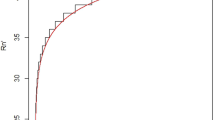Abstract
Microarrays are repositories of gene expression data that hold tremendous potential for new understanding, leading to advances in functional genomics and molecular biology. Cluster analysis (CA) is an early step in the exploration of such data that is useful for purposes of data reduction, exposing hidden patterns, and the generation of hypotheses regarding the relationship between genes and phenotypes. In this paper we present a new model for the clique partitioning problem and illustrate how it can be used to perform cluster analysis in this setting.
Similar content being viewed by others
References
S. Chopra and M.R. Rao, “The partition problem,” Mathematical Programming, vol. 59, pp. 87–115, 1993.
U. Dorndorf and E. Pesch, “Fast clustering algorithms,” ORSA J. Comput., vol .6, pp. 141–153, 1994.
F. Glover, G. Kochenberger, B. Alidaee, and M. Amini, “Tabu search with critical event memory: An enhanced application for binary quadratic programs,” in Meta-Heuristics, Advances and Trends in Local Search Paradigms for Optimization, S.M.S. Voss, I. Osman, and C. Roucairol (Eds.), Kluwer Publisher, 1999, pp. 93–109.
M. Grotschel and Y. Wakabayashi, “A cutting plane algorithm for a clustering problem,” Mathematical Programming, vol. 45, pp. 59–96, 1989.
M. Grotschel and Y. Wakabayashi, “Facets of the clique partitioning polytope,” Mathematical Programming, vol. 47, pp. 367–387, 1990.
D. Jiang, C. Tang, and A. Zhang, “Cluster analysis for gene expression data: A survey,” IEEE Transactions on Knowledge & Data Engineering, vol. 16, pp. 1370–1386, 2004.
G. Kochenberger, F. Glover, B. Alidaee, and C. Rego, “A unified modeling and solution framework for combinatorial optimization problems,“ OR Spectrum, vol. 26, pp. 237–250, 2004.
G. Kochenberger and Fred Glover, “A unified framework for modeling and solving combinatorial optimization problems: A tutorial,” in Multiscale Optimization Methods and Applications, W. Hager and P. Pardalos (Eds.), (to be published by Springer in 2005).
A. Mehrotra and M. Trick, “Cliques and clustering: A combinatorial approach,” Operations Research Letters, vol. 22, pp. 1–12, 1998.
10 M. Oosten, J. Rutten, and F. Spieksma, “The clique partitioning problem: Facets and patching facets,” Networks, vol. 38, pp. 209–226, 2001.
W. Shannon, R. Culverhouse, and J. Duncan, “Analyzing microarray data using cluster analysis,” Pharmacogenomics, vol. 4, pp. 41–52, 2003.
Author information
Authors and Affiliations
Corresponding author
Rights and permissions
About this article
Cite this article
Kochenberger, G., Glover, F., Alidaee, B. et al. Clustering of Microarray data via Clique Partitioning. J Comb Optim 10, 77–92 (2005). https://doi.org/10.1007/s10878-005-1861-1
Issue Date:
DOI: https://doi.org/10.1007/s10878-005-1861-1




